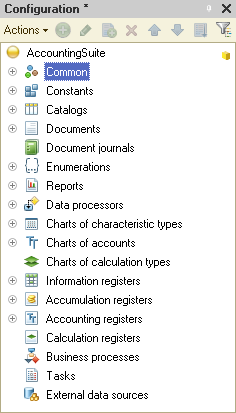The configuration object tree represents an applied solution, each branch describing a configuration component. Each root branch contains configuration objects that are logically connected to each other and have a common purpose.

In the configuration window, configuration objects are represented by their names. For example, the Chart of characteristic types of branch stores all chart of characteristic types objects available in the configuration, while the AdditionalDataAndAtributes branch describes a single chart of characteristic types having this name.

The content of each configuration object is also a tree-like structure, which contains subordinate configuration objects.
Configuration tree features
You can perform the following actions in the configuration tree:
- Create configuration objects
- Edit configuration objects
- Delete configuration objects and check the configuration for references to objects being deleted
- Change the order of configuration objects within their parent group
- Find the object whose properties are being edited in an object editor window, form editor, module editor, or template editor
- Sort configuration objects subordinate to a specific configuration object by name, synonym, or comment
- Search for references to a configuration object in other configuration objects
- Search for references to other configuration objects in a configuration object
- Filter configuration objects to view objects included in a specific subsystem defined in the configuration, or objects not included in any subsystem
- Run wizards for specific configuration objects
Next page: Configuration objects
See also:

